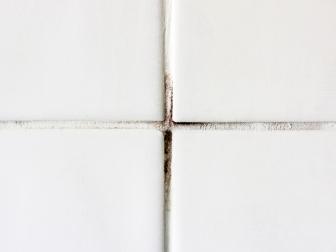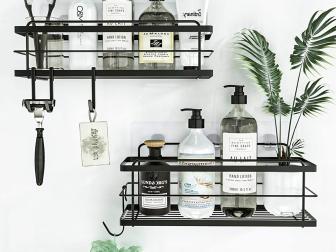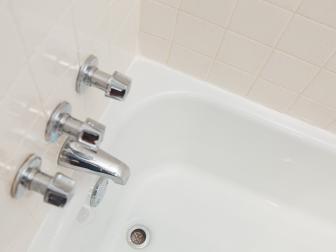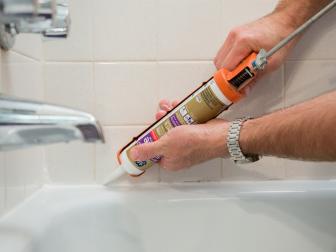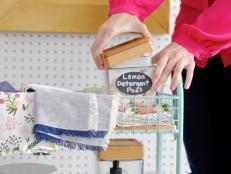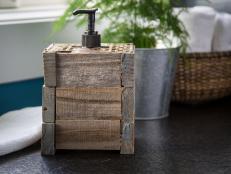How to Clean a Shower
Here's how you get rid of soap scum and shower grime so that your once-sparkly shower can shine again.

Drone Media Hub

Think beyond your weekly wipe-down and learn how to deep clean your shower to make it new again. We strive to be eco-conscious in our own homes and one of the best ways is to make DIY shower cleaners. Most of these tips include the use of sodium carbonate, white vinegar or oxygen-based bleach (hydrogen peroxide, sodium percarbonate or sodium perborate as opposed to chlorine-based bleach). Oxygen-based solutions are indeed a safer alternative for indoor cleaning, are more eco-friendly and can be extremely effective. Your next shower will be heavenly — guaranteed.
How to Clean a Tile Shower
Who doesn't love a clean tile shower? From porcelain to ceramic, every tile shower gets dirty from time to time and needs a good cleaning. Plus, grout left uncleaned can make your whole bathroom look dingy. Get ahead of the grime with the steps below.

FotoDuets / iStock
1. Make a grout cleaning paste by combining two parts washing soda and one part hydrogen peroxide to make a chlorine-free, bleach-free paste for cleaning and disinfecting grout.
2. Scrub grout with an old toothbrush and apply the paste to the grout lines. Allow it to sit for a few minutes, then use the toothbrush again to rinse it away with water. This will brighten dingy white grout and keep mold growth at bay.
3. Wipe down the tiles. When it comes to the tiled walls, water droplets tend to sit and air dry, making water spots and dried streaks nearly unavoidable. Unless you’re going to wipe down the shower with a dry towel after every use, you’ll need to find a good routine to keep water deposits on tiled surfaces under control. For most non-porous tile surfaces, that can be done simply using a cloth wet with diluted white vinegar. Wipe the walls down then follow up with a dry cloth to buff the surface.
Pro Tip: Apply a tile and grout protectant to keep your tiles looking spot-free after deep-cleaning.
How to Clean Grout
Show that mold and mildew who’s boss with our best tips and tricks for cleaning grout.
How to Clean a Fiberglass Shower
Fiberglass showers and tubs remain a popular choice for two reasons: they're inexpensive and incredibly easy to clean.
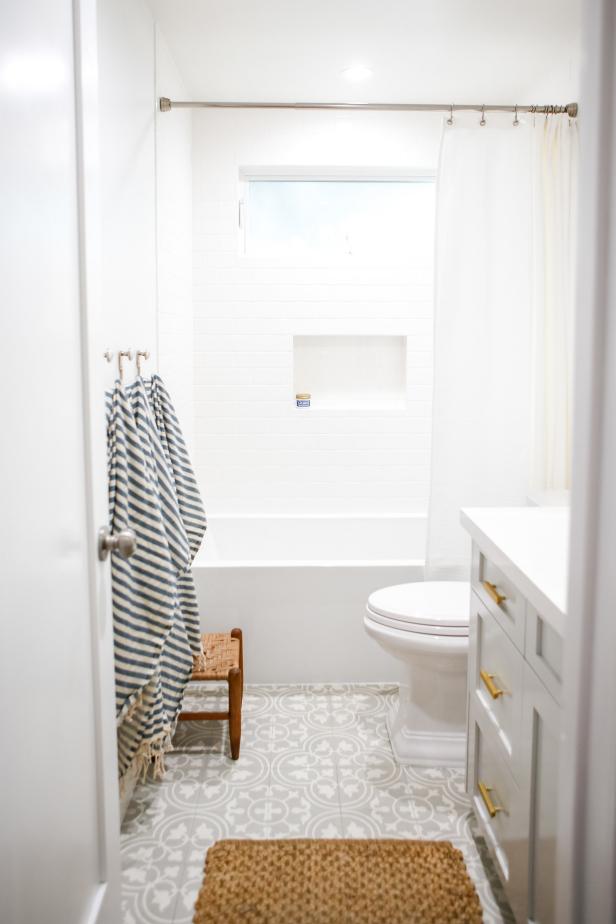
Marisa Vitale
1. Make a fiberglass cleaning solution by or combining one part distilled white vinegar and one part dish soap or buy a fiberglass shower cleaning product like the Scrubbing Bubbles Disinfectant Spray.
2. Spray down the shower by loading your solution into a spray bottle and thoroughly spray the shower walls and floor, including the hardware.
3. Let it soak for several minutes to work on releasing the grime.
4. Scrub the shower and all hardware with a soft-bristle brush. Refrain from using more abrasive scrubbing tools as they can scratch the surface, leading to quicker grime build-up in the future.
5. Rinse and wipe the shower free from cleaner and grime, then use a squeegee to remove the water before it dries on the surface.
How to Clean a Stone Shower
Natural stone showers, while beautiful, can be a little picky when it comes to cleaning. Follow the steps below to clean your stone shower without damaging the stone.

Intero Real Estate Services, Inc., a member of Luxury Portfolio International
1. Buy or make a cleaning solution. Natural stone shower surfaces, like marble and granite, don’t react well to acidic or otherwise harsh cleaning products. Many stone shower surfaces can be cleaned with a solution of warm water and a little dish soap, but we recommend buying a cleaner specifically formulated for your shower’s stone surface for optimal cleaning and protection, like Black Diamond's Marble & Tile Cleaner.
2. Spray down the walls using your cleaner or dish soap solution.
3. Scrub and rinse with a microfiber towel to remove any surface grime, then rinse away the cleaner using water.
4. Dry the stone using a dry microfiber cloth. Do this immediately after rinsing to avoid water spots and streaking.
5. Reseal the stone. This step is optional, depending on your specific natural stone shower material. Your stone may require sealing after a deep clean to prevent bacteria growth and staining. Purchase a stone sealant, like Black Diamond's Shower Sealer, formulated for your specific stone and apply it according to the manufacturer’s instructions.
How to Clean the Shower Drain
From soap scum to dirt to drain-clogging hair, we know your shower drain could use a good cleaning.
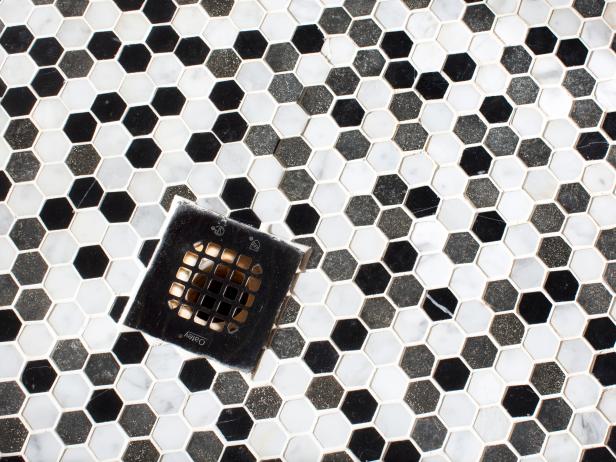
1. Scrub the drain by applying the cleaner with an old toothbrush around the edges of the drain to get residual grime and build-up.
2. Remove the cap. Desire a deeper clean? Remove the cap of the drain to clean underneath it and, if necessary, remove hair build-up before it affects water drainage.
3. Remove Clogs. If your drain is already clogged, don a pair of gloves and pull the hair out of the drain. If necessary, grab a small screwdriver to hook the hair and pull it out.
4. Snake the Drain. For serious clogs that are below the drain, get your hands on a drain snake. Push it down the drain and pull it back upward to extract hairs that may be affecting water flow. I promise, when it’s your own hair, it’s not too gross. And it’s worth it because this remarkably simple chore can save you time and the cost of a plumber.
How to Clean a Showerhead
Showerheads tend to harbor bacteria and mineral scaling, which can threaten your health and block water flow. Clean yours today and reclaim your shower's water pressure.

Tomas Espinoza
1. Spray the showerhead with white vinegar. If your showerhead is in relatively good shape this should prevent build-up. Be careful not to get vinegar on stone shower surfaces.
2. Soak the showerhead in a 50/50 white vinegar and water mixture for a deeper clean. Remove the showerhead from the wall, soaking it in the mixture in a basin or sealed in a plastic bag. The vinegar will help to loosen the residues on the surface (as well as any clogs inhibiting water flow). After an hour, use a sponge to wipe it down, then run water through the spout to clear out all the vinegar.
3. Reinstall the Showerhead by using a new piece of PTFE tape (plumber’s tape) between the showerhead and the threaded pipe coming from the wall to prevent leaks.
How to Deep Clean Your Showerhead (And Why It's Important)
Tackle blocked spray jets and mineral build-up on your bathroom showerhead with this deep-cleaning solution.
How to Clean a Shower Caddy
Soap spots, shampoo bottle rings and hard water build-up are just a few of the things that’ll make your caddy look dingy. Look a little deeper — especially into basket corners or mesh pouches — and you probably won’t like what you see.
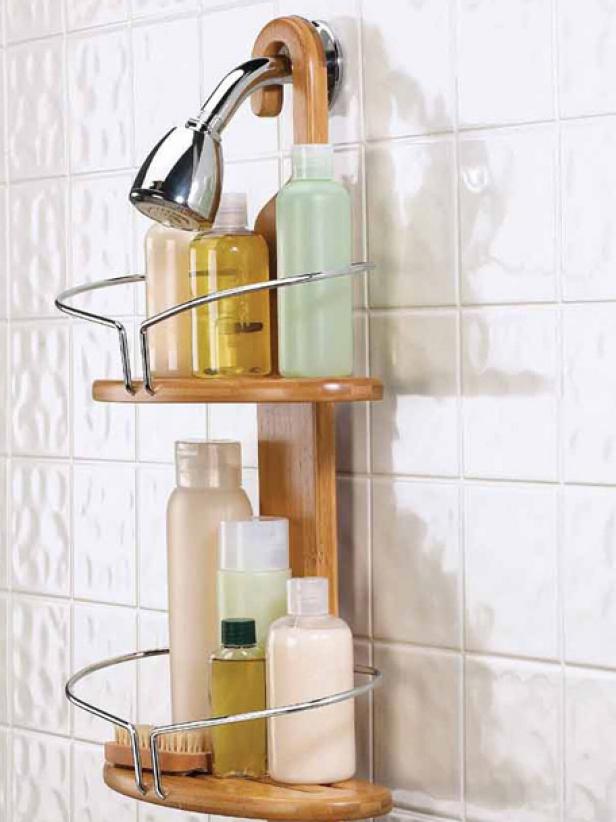
1. Remove the contents of the caddy before cleaning the container.
2. Wipe down the shower caddy with soap and water. If necessary, spray hydrogen peroxide on moldy areas.
3. Repaint the shower caddy if its paint is chipping. If your caddy is coated steel, it’s common for the paint or coating to chip away over the years, leading to rust. To prolong the life of an old wire shelf caddy, remove it from the bathroom, use sandpaper to remove any loose paint and rust, then apply a fresh coat of spray paint to seal the surface. If it's beyond saving or you simply want to switch things up, go ahead and buy a replacement. While you're at it, do your body a big favor and rotate in a new loofah, too. You deserve it.
The Best Shower Organizers and Caddies
Bring order to your shower with these smart storage solutions that corral bathroom clutter.
How to Clean a Shower Curtain
While you're cleaning your shower, don’t overlook the curtain.
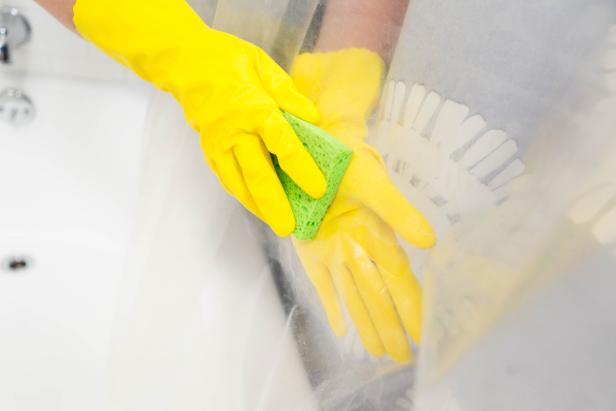
Johnson Giles of Loch & Key Productions
1. Wash a cloth curtain in the washing machine. Remove the shower curtain and plastic liner from the rod. Following the manufacturer's directions, launder the fabric curtain to remove dust, toilet germs and possible mildew.
2. Wash or replace the plastic or cloth liner. A plastic liner can be replaced at minimal cost, but if you would like to extend its life, lay it flat outdoors and spray it with a 50/50 mixture of white vinegar and water. Wipe it down and rinse it clean with the hose.
Mold often accumulates at the bottom of the curtain where it sticks to the tub and never seems to dry, so scrub them with a mixture of washing soda and hydrogen peroxide, then rinse them away. Avoid chlorine-based bleach, as it may discolor the plastic.
Pro Tip: If you trim the plastic shower curtain to just barely overlap the wall of your tub, you can limit the growth of mildew and encourage the liner to dry faster without sacrificing function.
How to Clean a Glass Shower Door
Glass shower doors rarely look as spot-free and crystal clear as they do in cleaning commercials, so to say they require a bit of routine upkeep is something of an understatement. See our steps on how to keep your glass shower door looking squeaky clean.

Regan Wood
1. Dry the door after every shower. To maintain clarity, it’s important to dry the door with a squeegee or a cloth — not only on deep cleaning days but every day.
2. Remove any water spots. Water drips and build-up accrues quickly and can be combatted with a powerful mix of glass cleaner that uses cornstarch, white vinegar, rubbing alcohol and water to scrub at build-up without threatening to scratch the glass. While you're at it, this is a great mirror cleaner as well.
How to Clean and Repair Caulk
Silicone caulk doesn't last forever, but a gentle cleaning can keep your shower's caulk looking its best for years. However, when it starts peeling and retracting, it's time to replace it.
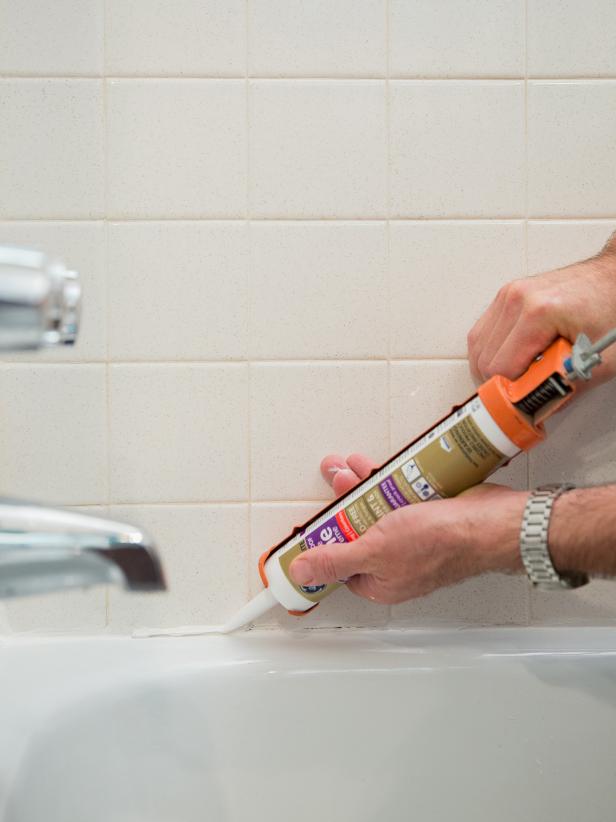
Jalynn Baker
1. Make a caulk cleaning paste. Make a paste by mixing 50/50 washing soda and hydrogen peroxide.
2. Apply the paste to the caulk. Avoid scrubbing the paste in, as you don't want it to loosen or agitate any in-tact caulking. After the solution sits for a few minutes, rinse it away and dry the area with a towel.
3. If necessary, remove the caulk and replace. If your caulk is peeling, dried out or retracted from the joint, you’ll want to replace it with new, clean caulk. Carefully cut the caulk out using a razor blade, clean the surface, then apply a new bead of caulk. Let it dry according to the manufacturer's instructions before using the shower.
How to Caulk a Shower
Follow these simple steps to remove and replace caulk in the shower and bathtub when it starts to mildew and pull away from the shower wall.
How to Use a Caulk Gun
It’s finally time to replace that dingy, discolored caulk that keeps cracking around your sink. Skip the call to the handyman because everything you need to know about caulking and how to use a caulking gun is right here.
How to Clean Mold and Mildew
Mold and mildew can grow quickly in any bathroom and, once it’s there, it's hard to get rid of. You might be accustomed to using a chlorine-based bleach for disinfecting — and sure, it’ll help kill mold and neutralize spores — but a better alternative is to use a mixture of hydrogen peroxide with an oxygenated powder product, such as OxiClean, or my favorite, generic washing soda (not to be confused with baking soda). If you look at ingredients in many of the heavy-duty mold abatement products, you’ll spot that hydrogen peroxide is a common ingredient, so it’s no surprise that this at-home solution is so effective.
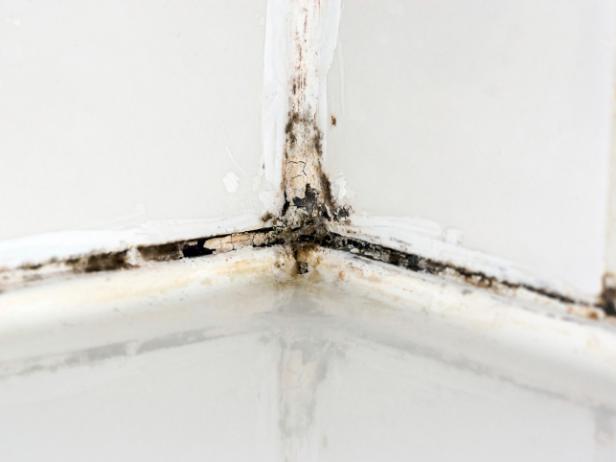
RUDI TAPPER
1. Make a DIY mold cleaner by combining 50/50 washing soda and hydrogen peroxide to form a paste.
2. Apply the paste to the mold areas in the shower to treat the spots and spores safely.
3. Wipe and rinse the area after it has sat for a few minutes and use a cloth to wipe it clean. Mold-be-gone!
Cleaning Black Mold
Learn how to clean black mold, prevent its spread and guard against its return.







